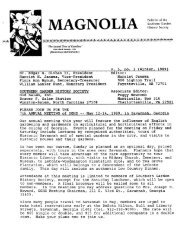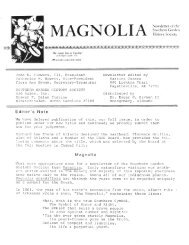Vol. XII, no. 2, 3 & 4 - Southern Garden History Society
Vol. XII, no. 2, 3 & 4 - Southern Garden History Society
Vol. XII, no. 2, 3 & 4 - Southern Garden History Society
You also want an ePaper? Increase the reach of your titles
YUMPU automatically turns print PDFs into web optimized ePapers that Google loves.
wrote "planted the above in my garden in<br />
Williamsburg, February 1790 . "<br />
Tucker succeeded George Wythe as<br />
professor of law at William and Mary in 1790<br />
and the following year he remarried . His<br />
second wife, also a widow, had two children . He r<br />
name was Lelia Skipwith Carter. At this time Tucker<br />
focused his attentions on his Williamsburg property.<br />
In Williamsburg, Tucker gardened for thirty<br />
years in addition to the ten previous years<br />
Shurcliffs 1931 plan of Tucker House .<br />
experience at Matoax. His almanacs describe the<br />
grounds and gardening activities sporadically ,<br />
probably because of his busy lifestyle . From written<br />
records we k<strong>no</strong>w that he maintained a kitche n<br />
garden, a pleasure garden, and an orchard . An<br />
inventory of Tucker's library taken several year s<br />
after his death lists two important gardening books :<br />
Philip Miller's The <strong>Garden</strong>er's Kalendar, directing<br />
what works are necessary to be performed in the<br />
kitchen, fruit and pleasure gardens, as also in th e<br />
conservatory or nursery (1769), and Willia m<br />
Forsythe's Treatise on the Culture and Management<br />
of Fruit Trees . Both works were probably<br />
indispensable in Tucker's gardening efforts . Tucker's<br />
detailed descriptions of his garden provide us wit h<br />
a list of plants from which to draw when replantin g<br />
it. For example, a 1794 almanac entry stated that on<br />
"16 March Apricots beginning to bloom . 22nd In the<br />
course of the last week peaches, nectarines ,<br />
cherries and plums bloom . Blossoms o f<br />
apples and pears appear. Leaves of the locust<br />
appear. Lombardy poplar beginning to show<br />
its leaf. Ashen buds swelled — green willows<br />
partly — yellow willows more generally and<br />
weeping willow in full leaf. Flowering almond<br />
blooms. 24th Double blossom peach beginning to<br />
bloom. "<br />
Tucker sometimes also recorded what h e<br />
planted and where. In November 1791 he<br />
<strong>no</strong>ted planting peach stones "near the stable<br />
door." According to an 1815 insurance policy ,<br />
the stable stood due west of the house alon g<br />
Palace Green. Willow trees stood at the south<br />
and east sides of the stable . Tucker wrote that<br />
on March 12, 1807 raisin stones and Malap a<br />
grapes "were sown in a box and under th e<br />
willow tree and at the east end of th e<br />
stables." Several times Tucker wrote that h e<br />
planted seeds and plants under a willow ,<br />
probably for the protection it provided . An<br />
almanac entry from October 1792 mentioned<br />
eight peach stones, including six lemon<br />
peach stones planted "near the nursery, "<br />
however, the location of the nursery remain s<br />
unk<strong>no</strong>wn. Large white pears were plante d<br />
"near the east pales" and four other peach<br />
stones were planted "at the corner of th e<br />
lawn on the south side of the pales, eas t<br />
end." The location and length of fencing o n<br />
the property is also currently unk<strong>no</strong>wn .<br />
Comments such as these are valuable for<br />
determining garden layout. Unfortunately, <strong>no</strong><br />
maps or sketches of Tucker's garden hav e<br />
been discovered, leading us to speculate as to<br />
its layout and style, which could have changed over<br />
time .<br />
In 1804, Tucker resigned as Professor of Law a t<br />
William and Mary to become Judge of the Court of<br />
High Appeals, which often took him away on<br />
business. Tucker's daughter, Fanny, wrote to her<br />
husband in 1810 of her father's reluctance to leave<br />
his garden in April . "It seems hard at his time of life<br />
to leave such a home as this and at this season too ,<br />
when spring is putting forth all her charms . The<br />
double blossoms are beginning to look beautifu l<br />
and the garden will soon exhibit many sweet an d<br />
ornamental shrubs in perfection." Dr. Barraud, who<br />
often looked after Tucker's house while he was<br />
away, praised the back garden in May 1814, saying ,<br />
"I am <strong>no</strong>w beholding the lawn from your door, so<br />
beautiful green and so richly spangled with th e<br />
yellow flower — it is beautiful and serene . "<br />
4
















